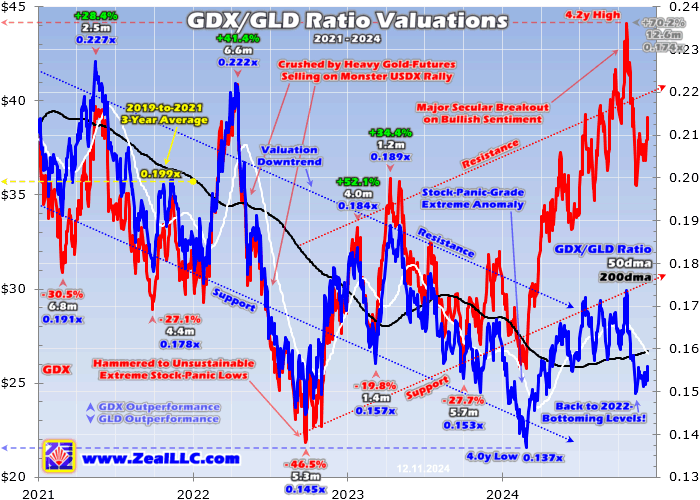Stocks in the gold sector continue to represent significant bargains as they remain priced based on much lower historical gold prices. Gold miners are currently experiencing record profits, driven by a robust bull market in gold. However, traders have been slow to react, resulting in gold stocks being considerably undervalued compared to their earnings. This discrepancy is unlikely to persist, as stock prices typically adjust to align with a reasonable multiple of corporate profits.
A year ago, gold was trading around $2,000, a figure deemed quite high at that time following gold’s nominal record close of $2,071 achieved after a 3.3-year wait. Despite this, the market sentiment was somewhat bearish on gold. In my analysis from that week, I maintained a bullish stance, suggesting, “While $2,450 is within reach, I feel more comfortable predicting a conservative 25% increase for gold, bringing its price to approximately $2,275.”
This contrarian prediction materialized in early April, with gold prices continuing on an upward trajectory. By mid-September, the price surge reached impressive levels, registering gains over 40% before peaking in late October with a remarkable increase of 53.1% over a period of 12.9 months. During this time, gold recorded an astounding 43 record closes, the last being $2,786 six weeks ago, leaving the market in an overbought condition with speculative positions in gold futures reaching extreme levels.
As a result, gold faced a high likelihood of a necessary correction to adjust sentiment and technical indicators, which occurred shortly thereafter. However, the pullback was relatively mild, reaching a maximum of only 8.0% by mid-November, indicating that the bullish trend in gold remains intact. The strong performance of gold this year has been supported by substantial global demand from Chinese investors, central banks, and Indian jewelry purchasers, signaling a shift toward a higher-price regime for gold.
As we approach the end of 2024, the average closing price for gold this year stands at $2,378, significantly surpassing the averages from previous years: $1,798 in 2021, $1,801 in 2022, and $2,077 in 2023. Gold stock prices should reflect these elevated gold prices, which overwhelmingly influence their earnings. Yet, over the same four-year period beginning in 2021, the leading GDX gold-stock ETF showed average prices of $33.76, $29.88, $35.85, and $34.79.
From 2021 to 2024, while average gold prices surged by 32.2%, average gold stock prices in the GDX merely increased by 3.1%. This is a remarkable anomaly, as historically, major gold stocks included in this ETF have amplified significant movements in gold prices by a factor of 2 to 3. This amplification is driven by the substantial profitability that gold mining enjoys when gold prices rise, as mining costs increase at a much slower pace, resulting in significant earnings growth.
Following each quarterly earnings report, I thoroughly examine the results from GDX’s 25 largest component stocks. The most recent data, covering Q3 2024, revealed an impressive average gold price of $2,477. In contrast, the average all-in sustaining costs for the top 25 GDX miners were significantly lower at $1,431 per ounce, resulting in sector unit profits of $1,046—up an astonishing 74.0% year-over-year (YoY), marking the fifth consecutive quarter of substantial growth.
Starting from Q3 2023, the implied unit profits for the GDX top 25 have seen YoY increases of 87.2%, 42.3%, 34.9%, 83.7%, and 74.0%. In the first three quarters of 2024, those profits averaged $980 per ounce, an impressive 94.1% higher than the 2022 average, when gold prices were 24.3% lower. This significant growth in earnings makes it difficult to rationalize the mere 16.4% increase in GDX prices this year.
This unsustainable valuation disparity becomes even more apparent when compared using another metric. Considering that gold prices primarily drive gold-mining profits, examining the price levels of gold stocks relative to gold reveals clear undervaluation. The GDX/GLD Ratio, calculated by dividing GDX daily closes by the GLD gold ETF prices, indicates whether gold stocks are relatively cheap or expensive.
The GGR, represented in blue along with key technical indicators overlaid on the raw GDX data in red, shows that while major gold stocks have experienced notable gains—with GDX up 70.2% at its peak during gold’s surge—the upside leverage of 1.3x to gold falls significantly short of the historical range of 2x to 3x. This underperformance indicates that gold stocks continue to trade at secular-bottom levels compared to gold.
In late October, GDX reached a 4.2-year high and was less than 1% shy of its best closing price in nearly 12 years. Such a significant breakout would have revitalized market sentiment and drawn traders to gold stocks. Unfortunately, the subsequent Q3 results from Newmont, the world’s largest gold miner, derailed that momentum, as it reported disappointing all-in sustaining costs (AISCs), leading to a 14.7% drop in its stock.
This setback hampered sentiment at a time when gold was still setting new records; GDX faced a downturn, dragged down by Newmont’s poor performance. The GGR, which had been on the brink of breaking out of a multi-year downtrend, suffered considerably from this event, culminating in a further selloff fueled by gold’s overdue pullback.
GDX reached its nadir in mid-November, falling 19.5% as gold experienced a standard drop of 8.0%, resulting in a typical downside leverage ratio of 2.4x. The corresponding GGR reading of 0.150x was startling. While gold stocks had lagged earlier in gold’s impressive ascent, this particular decline was extraordinarily anomalous as well. Back in late February, when gold began to rise but gold stocks lagged behind, the GGR inexplicably dropped to 0.137x.
This marked a 4.0-year low, indicating that gold stocks were the most undervalued relative to gold since the turbulent days of March 2020, amid pandemic-related stock market panic.
Late February’s stock-panic-induced gold-stock pricing relative to gold was unsustainable, almost guaranteeing a significant mean-reversion rally. Even though current gold prices have not reached such extreme lows relative to their historical highs, they are nonetheless alarmingly close, signaling another imminent surge in gold stocks.
GDX trading at a GGR of just 0.150x mirrors the last major opportunity to buy gold stocks back in late September 2022, which erupted following an extreme dislocation caused by the Fed’s aggressive rate-hiking cycle. The resulting spike in yields pushed the US dollar to new heights, provoking massive selling in gold futures, causing gold to plummet by 20.9%, with GDX exacerbating the losses by 2.2 times, resulting in a significant 46.5% drop.
During that major low, the GGR fell to a minimum of 0.145x, averaging 0.154x around that period in September and October 2022. These levels are comparable to current readings, with the mid-November 2024 GGR at 0.150x and a similar average since the elections. Gold stocks have rarely been more undervalued relative to gold than they are now, and such extreme disparities are seldom sustained for long.
Following that late-2022 episode, GDX soared by 52.1% over the subsequent four months. Then, after hitting the GGR low in February 2024, GDX experienced a remarkable surge of 71.0% within a span of 7.8 months. A significant recovery in gold stocks is likely following this latest undervalued state. Consequently, we are actively adding fundamentally strong, fast-growing mid-tier and junior gold miners to our trading portfolios, as these companies are poised to outperform larger firms.
Historically, periods of low GGR extremes tend to be succeeded by major upward trends in gold stocks. Furthermore, gold miners generally not only revert to their normal GGR levels but often overshoot them proportionally. The last normal market years were arguably from 2019 to 2021, before the Fed’s drastic rate hikes commenced in 2022. During this period, the average GGR was 0.199x. A return to that average would necessitate a 33% rally in GDX.
A proportional overshoot could double that estimate to 66% gains for GDX majors, while smaller, more efficient mid-tier and junior miners may see even greater increases. This assumes that gold prices remain stable, suggesting that gold stocks need only catch up with the prevailing levels. Furthermore, there is a strong case for gold to continue its upward trajectory, particularly given that American stock investors have yet to pursue gold’s potential gains, and thus have an enormous buying opportunity ahead of them.
The last two substantial gold rallies in 2020 necessitated considerable capital inflow into gold ETFs to drive prices up by 40% or more. However, the current, even larger gold surge has not yet seen substantial investments in GLD and IAU. Many American stock investors, distracted by the prevailing AI stock bubble, have largely neglected gold. Once that bubble bursts, it is anticipated there will be a significant rush towards gold investments.
The leading 25 gold miners in GDX are also expected to report remarkable profits in the ongoing Q4 as well. As of now, gold is averaging $2,670 for the quarter, reflecting a staggering 35.1% YoY increase. If this trend continues in the next couple of weeks, it would mark the most significant gold price increase in the 34 quarters I have analyzed regarding major gold miners’ performance. Regardless of the outcome, Q4 2024 is set to record the highest average gold prices ever.
In the first three quarters of 2024, the GDX-top-25’s average all-in sustaining costs were $1,315 per ounce. Many gold mining firms are forecasting lower AISCs for Q4 due to increased production, including Newmont. However, to be conservative, let’s assume AISC remains high near $1,400. This would imply extraordinary record unit profits of $1,270 per ounce, representing a staggering 93% increase YoY. Gold miners are experiencing significant profitability.
Many gold stocks are currently trading at low-to-mid double-digit price-to-earnings ratios, rendering them incredibly undervalued. Additionally, the ongoing cycle of impressive earnings growth will drive valuations even lower. Such attractive bargains are likely to draw attention from value-oriented investors, and even a small influx of institutional buying could propel this contrarian sector much higher. Gold stocks are on the cusp of normalizing based on their earnings.
From a technical standpoint, this sector has substantial potential for rallying. Gold’s impressive ascent has soared by 53.1% at its peak since early October 2023. Historically, GDX has leveraged gold’s rises by a factor of 2 to 3. Therefore, even if the gold price stabilizes, GDX could see substantial increases ranging from 106% to 159% based on its previous October 2023 low, projecting GDX prices to rise between $53 to $67.
Currently trading at $39, GDX remains at these levels primarily due to weak sentiment towards gold stocks. Speculators and investors drawn to the AI stock bubble have largely overlooked gold and its associated mining stocks, resulting in a significant undervaluation. However, soaring profits will surely attract capital back to any sector. Gold stocks present a unique combination of low valuations and tremendous earnings growth.
As gold prices continue to rise, sentiment towards gold stocks will inevitably turn bullish, prompting increased buying. The upward trajectory of gold and gold stocks will lead to more favorable coverage in financial media, further raising traders’ awareness of the substantial upside potential and driving them to participate. This cycle of buying can create momentum, further enhancing prices and attracting more capital inflows.
With gold currently trading just 2.5% below its late October record close, it is perplexing to see gold stocks languishing at historically low levels relative to their correlated metal. This unsustainable discrepancy presents significant opportunities for astute contrarians. The key to wealth accumulation lies in buying low and later selling high, making this first step critical. Clearly, gold stocks are currently undervalued.
Although GDX is positioned for significant valuation recovery, smaller mid-tier and junior gold miners with strong fundamentals are likely to outperform. These smaller entities traditionally operate lower-cost mines and can sustainably grow production from smaller bases. In the last quarter, the GDXJ top 25 mid-tiers had an average AISC of $1,331, which was $100 lower than the GDX top 25 majors who averaged $1,431.
In summary, gold stocks currently represent outstanding buying opportunities. While gold is near recent record highs, major gold stocks in GDX are substantially undervalued, trading at levels reminiscent of late 2022’s major low. Despite gold miners achieving record profits and six consecutive quarters of significant earnings growth, they remain largely ignored by traders.
This unsustainable situation is bound to change, as stock prices inevitably adjust to reflect fundamental earnings. The impressive profits generated by gold miners will drive their stock prices significantly higher. The anticipated mean-reversion buying will enhance bullish sentiment, attracting more traders to chase upside opportunities in gold stocks. Getting in now could prove to be a highly lucrative decision.






